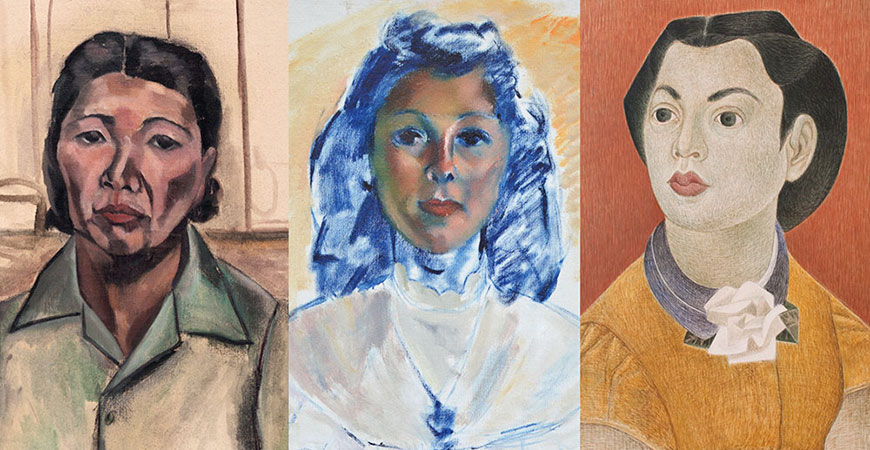
A new art exhibition curated by Professor ShiPu Wang is reintroducing the diverse art of three California painters to a national audience by bringing representative works from each together for the first time.
“Pictures of Belonging: Miki Hayakawa, Hisako Hibi, and Miné Okubo” will travel to five museums across the country, including a nine-month display at the Smithsonian American Art Museum.
With more than 100 paintings, drawings and photographs, the exhibition is designed to reveal a broader picture of the American experience through artworks and life stories of three Japanese American women from the pre-World War II generation.
“From portraiture and figurative works to landscapes, still lifes and abstractions, the exhibition thematically and chronologically charts the artists’ sustained engagement with and contributions to various artistic, cultural and sociopolitical movements,” Wang said. “’Pictures of Belonging’ invites the viewer to not only appreciate and learn about these artists’ work, but also reflect on what (and who) defines American art in specific historical moments, while examining reasons for the omission of these artists from accounts and museum collections of 20th century art in the United States.”
Wang is the Coats Family Chair in the Arts and an art history professor in the Department of Global Arts, Media and Writing Studies in the School of Social Sciences, Humanities and Arts. He is also a commissioner of the Smithsonian National Portrait Gallery.
The exhibition opens Feb. 24 at the Utah Museum of Fine Arts, a meaningful venue to begin the national tour, as Hibi and Okubo were both incarcerated at the Central Utah Relocation Center (also known as Topaz) during World War II. It will then travel to four venues, including the Smithsonian American Art Museum and the Pennsylvania Academy of the Fine Arts on the East Coast, and the Monterey Art Museum in California, before concluding at the Japanese American National Museum (JANM) in Los Angeles in late 2026.
“By showing never-before-seen artworks from these female artists, ‘Pictures of Belonging’ encourages visitors to focus their attention on these and other diverse artists who blazed the trail at a time when female artists of color were afforded few opportunities,” said Ann Burroughs, president and CEO of JANM, the organizing institution of the exhibition’s tour.
Hayakawa (1899-1953), Hibi (1907-1991) and Okubo (1912-2001) were three of the most critically acclaimed and visible female artists of Japanese descent in American art before World War II, but their prolific and long careers have not received proper attention in 20th-century American art history, Wang said.
All three pursued their training in California, consistently showed works, and received honors in juried exhibitions by the San Francisco Art Association, the Oakland Art Gallery and other artist collectives throughout California. All three shared the distinction of being the only female Japanese American artists to represent the U.S. in the Golden Gate International Exposition in 1939-1940.
During World War II, all three women were forced from their homes in California. Hibi and Okubo were imprisoned at the Tanforan Assembly Center in San Bruno and then Topaz; Hayakawa moved to New Mexico and passed away there. Both Okubo and Hibi moved to New York City after they left the incarceration camps; Okubo settled in the Big Apple for the rest of her life, while Hibi returned to California in 1954 and became an active and beloved member of local art collectives.
All of them continued to make art through challenging circumstances and were committed to leveraging art as a productive means of storytelling and engaging with diverse communities, Wang said.
Through exhaustive research and rediscovery, Wang assembled artworks created across eight decades by these women who used artmaking to capture and make sense of their experiences, to make their presence and existence visible and to assert that they belonged — to “take up space,” as Wang phrased it.
By highlighting the artists’ distinctive styles, Wang said, “Pictures of Belonging” asks viewers critical questions such as: What does American art and being American mean in specific historical moments? How and why do existing accounts render women artists of color as peripheral or even invisible? What can we do to encourage a more inclusive, expanded, and nuanced understanding of American art and cultural history?
The accompanying exhibition catalogue was edited by Wang and co-published by JANM and the University of California Press. With contributions from a diverse group of scholars, curators, artists, writers and archivists, and 169 images, this 188-page, fully illustrated publication contains never-published artworks that will appeal to a wide audience and make it a helpful reference for future research and curatorial projects, Wang said.
The exhibition’s touring schedule is:

Senior Writer and Public Information Representative
Office: (209) 228-4406
Mobile: (209) 201-6255